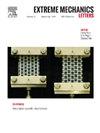应变率对弹性体结构材料响应的影响
IF 4.5
3区 工程技术
Q2 MATERIALS SCIENCE, MULTIDISCIPLINARY
引用次数: 0
摘要
建筑材料在冲击缓解和防护应用方面显示出巨大的前景,因此,人们对更好地表征它们在冲击引起的高应变率下的响应非常感兴趣。关于惯性和材料响应对应变率灵敏度的贡献,特别是当这些影响开始在结构材料的冲击响应中占据主导地位时,仍然存在不确定性。特别是软聚合物建筑材料的响应作为应变速率的函数,很少被研究。我们利用劈裂霍普金森压力杆加载和由此产生的变形场的高速视频表征,表征了四种软聚合物结构的晶格几何形状在不同应变速率下(~ 103 s−1)的实验冲击响应。我们的研究结果强调了组成材料、晶格几何形状、长度尺度和应变速率之间的相互影响,这些影响决定了显著惯性效应的开始。本文章由计算机程序翻译,如有差异,请以英文原文为准。
Influence of strain-rate on the response of elastomeric architected materials
Architected materials have shown substantial promise in impact mitigation and protective applications, and there has accordingly been great interest in better characterizing their response at elevated strain rates due to impact. There remains ambiguity regarding the contribution of inertial and material responses to strain rate sensitivity, and, in particular, when these effects begin to gain dominance in the impact response of an architected material. The response of soft polymer architected materials as a function of strain rate, in particular, has been little investigated. We characterize the experimental impact response of four soft polymer architected lattice geometries across varying strain rates in the intermediate strain rate regime (∼103 s−1) using split-Hopkinson pressure bar loading and high speed video characterization of the resulting deformation fields. Our results highlight the interplay of influence between constituent material, lattice geometry, length scale, and strain rate in determining the onset of significant inertia effects.
求助全文
通过发布文献求助,成功后即可免费获取论文全文。
去求助
来源期刊

Extreme Mechanics Letters
Engineering-Mechanics of Materials
CiteScore
9.20
自引率
4.30%
发文量
179
审稿时长
45 days
期刊介绍:
Extreme Mechanics Letters (EML) enables rapid communication of research that highlights the role of mechanics in multi-disciplinary areas across materials science, physics, chemistry, biology, medicine and engineering. Emphasis is on the impact, depth and originality of new concepts, methods and observations at the forefront of applied sciences.
 求助内容:
求助内容: 应助结果提醒方式:
应助结果提醒方式:


